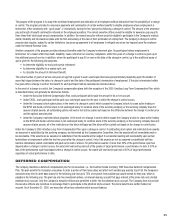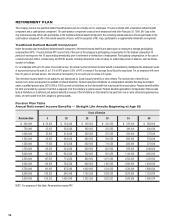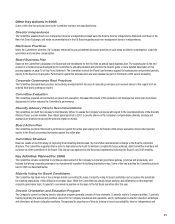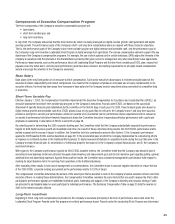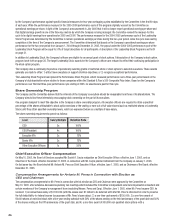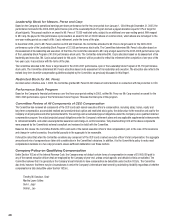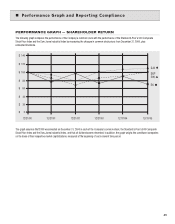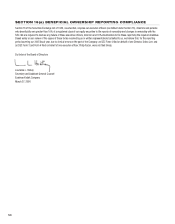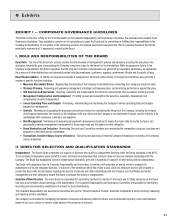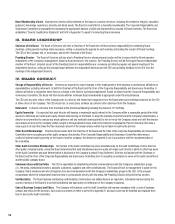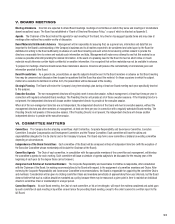Kodak 2005 Annual Report Download - page 201
Download and view the complete annual report
Please find page 201 of the 2005 Kodak annual report below. You can navigate through the pages in the report by either clicking on the pages listed below, or by using the keyword search tool below to find specific information within the annual report.45
Components of Executive Compensation Program
The three components of the Company’s executive compensation program are:
• base salary;
• short-term variable pay; and
• long-term incentives.
In July 2005, the Company announced that the three metrics by which it is being managed are digital revenue growth, cash generation and digital
earnings growth. The performance goals of the Company’s short- and long-term compensation plans are aligned with these corporate objectives.
That is, the performance goals of the Company’s short-term variable pay plan are digital revenue and investable cash, and the performance goal of
the Company’s long-term incentive Leadership Stock Program is digital earnings from operations. The various compensation elements support the key
objectives of the Company’s compensation programs. For example, the use of stock options (and in certain instances, SARs) aligns the interests of the
Company’s executives with the interests of the shareholders by ensuring that gains accrue to management only when shareholder value appreciates.
Performance-based awards, such as the performance stock unit Leadership Stock Program and the short-term variable pay EXCEL plan, ensure that
payouts occur only when short- and long-term performance goals have been achieved, and vesting requirements on all equity-based compensation
awards encourage the retention of the Company’s executives.
Base Salary
Base salary is the only fi xed portion of an executive’s direct compensation. Each senior executive’s base salary is reviewed annually based on the
executive’s relative responsibility and market comparisons. As a result of the Company’s emphasis on increased use of equity compensation for its
executive offi cers, the trend has been away from increases in base salary for the Company’s senior executives unless warranted by competitive data
or promotion.
Short-Term Variable Pay
Effective January 1, 2002, the Compensation Committee implemented the Executive Compensation for Excellence and Leadership Plan (EXCEL), an
executive assessment and short-term variable pay program for the Company’s executives. Payouts under EXCEL are based on the successful
attainment of specifi c fi nancial goals established by the Committee in the fi rst 90 days of each year. For 2005, these fi nancial goals were based on
digital revenue growth and investable cash fl ow. EXCEL places focus on key goals that are critical to the Company’s short- and long-term success,
provides a strong tie to current year performance, allows for rewards at an accelerated rate for performance above expectations and for reduced or
no awards if performance falls below threshold targets and allows the Committee discretion in assessing individual performance with a particular
emphasis on leadership. A description of EXCEL is set forth on page 28.
As a starting point in determining the 2005 corporate funding pool, the Committee noted that the Company substantially exceeded its performance
targets for both digital revenue growth and investable cash fl ow. As a result of these extremely strong results, the 2005 EXCEL performance matrix
yielded a payout well in excess of target. In addition, the Committee took into consideration several other factors: 1) the Company’s performance
against its 2005 baseline EXCEL metrics described on page 28; 2) the accelerated pace at which the Company implemented its restructuring efforts
in response to continued declines in the traditional fi lm business; 3) digital revenues attributable to acquisitions made during the year that were in the
Company’s revised fi nancial plan; 4) monetization of intellectual property that was not in the Company’s original fi nancial plan; and 5) the Company’s
overall performance.
With regard to the Company’s performance against its 2005 EXCEL baseline metrics, the Committee noted that the Company was ahead of plan in
executing its new business model and achieved its supply chain/inventory and improvement goal and its cost reduction goal regarding selling, general,
administrative and advertising expenses. Against these positive results, the Committee also considered management’s performance with respect to
meeting its target baseline metric for earnings from operations in the traditional business.
After evaluating these results in total and at management’s recommendation, the Committee chose to exercise negative discretion to reduce the size
of the 2005 EXCEL corporate funding pool yielded by the performance matrix to 152% of target.
The Compensation Committee determines the amount of the award pool that is allocated to each of the Company’s named executive offi cers and other
executive offi cers. In making these determinations, the Compensation Committee considers the same factors that are used to assess the Plan’s other
participants: performance against pre-established individual goals, leadership and support of the Company’s diversity and inclusion strategy. Funds
are allocated to participants based on each participant’s individual performance. The Summary Compensation Table on page 25 lists the awards for
2005 to the named executive offi cers.
Long-Term Incentives
Beginning in 2004, long-term compensation is provided to the Company’s executives principally in the form of performance stock units under the
Leadership Stock Program. Awards under this program are entirely performance-based. Payouts under the Leadership Stock Program are determined


